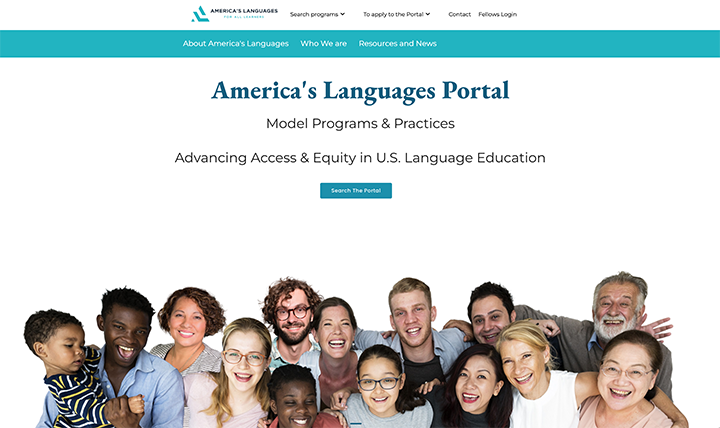

To help connect educational innovations with the learners who want and need them most, the America’s Languages Working Group is launching a first-of-its-kind online resource on March 14. The America’s Languages Portal: Model Programs and Practices Advancing Access and Equity in US Language Education (www.americaslanguages.org) is a registry of programs that can be emulated and adapted by on-the-ground efforts across the country to introduce students from diverse populations to effective language instruction. The portal collects advances in pre-K–12, college and university, and community-based language education, specifically the advances that improve access for more of the nation’s neglected learners and languages.
The idea is to prove that it is possible, even feasible, to provide the language and intercultural skills the country needs to address critical social justice issues at home as well as those directed at a more collaborative, interdependent, and just world. In so doing, it will illustrate the aspirations and achievements of the language profession: broader and more equitable access, accountability in programming and instruction, and a more diverse portfolio of language offerings.
In particular, the portal focuses on programs that aspire to full and equal access for Black communities and people of color; economically disadvantaged learners in rural and inner-city communities; Latinx populations, including English learners; and Native American, heritage, immigrant, and refugee communities.
The America’s Languages Working Group was first convened by the American Academy of Arts and Sciences to help support the recommendation of its 2017 report, America’s Languages: Investing in Language Education in the 21st Century. The working group now comprises leaders and stakeholders across the language enterprise—from government, industry, education, NGOs, and Native American and heritage, immigrant, and refugee communities—all of whom volunteer their time to strengthen language education.
Construction of the website began in 2019, with leadership from the American Councils for International Education, one of the organizations represented in its membership. Earlier this year, the Center for Open Educational Resources and Language Learning (COERLL) and the Texas Language Center at the University of Texas at Austin assumed day-to-day operations of the site—all with funding from the Andrew W. Mellon Foundation.
“Our hope is that the site will inspire a groundswell of more accessible and more effective programming across the country, when teachers and funders see what’s possible,” says John Tessitore, chair of the working group.
The portal includes extended descriptions of exemplary programs, collected through an open and continuing selection process. Any program may apply that feels it meets the criteria defining increased access. The process of selecting programs is the responsibility of a cadre of America’s Languages Fellows—distinguished teachers, administrators, and researchers—who must approve the model programs of every size and any location.
Educators at every level will be able to visit the site for contacts, inspiration, and successful models for their own work, as may policymakers and funders interested in advancing access to language education in the US.
The portal’s emphasis on Native American language and heritage language programs, often overlooked in academic settings, is among its most innovative features.
“The portal is a new way to highlight the vibrancy and breadth of Native American language revitalization efforts,” says Leslie Harper, president of the National Coalition of Native American Language Schools and Programs. “There are hundreds of distinct Native American languages across the US, each unique in context and approach to language sustenance. We hope the portal provides an opportunity to elevate the visibility and determination of Native American language schools and community programs, and generates new connections.”
“This site provides the most comprehensive landscape of heritage languages in higher ed, K–12, and community-based institutions, the three main pillars of America’s language programs,” says Tommy Lu of the Coalition of Community-Based Heritage Language Schools. “We now have a central site where all heritage language programs can be documented, located, and shared. It is not a competition, it is the largest collaboration project so far.”
Ultimately, the portal reframes language education as a vital component of social justice and equity.
“Our political system, our justice system, our health care system, our communities cannot function properly if we cannot communicate with each other,” says Richard Brecht, director of the portal project and co-director of the American Councils Research Center. “What the working group is trying to prove with this website is that we can meet the needs of all Americans, whether they are born here or abroad, whether they grew up in rural towns, big cities, or on Native lands. Everyone can and should have access to quality language education, and the new portal will offer concrete examples of how to make that happen.”
www.americaslanguages.org







